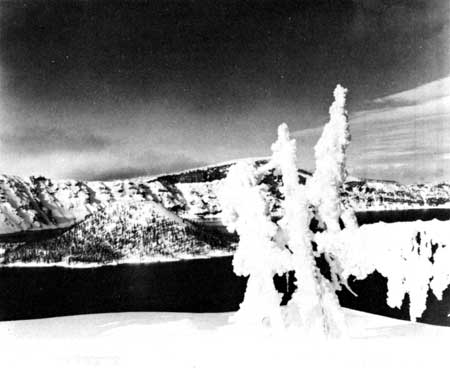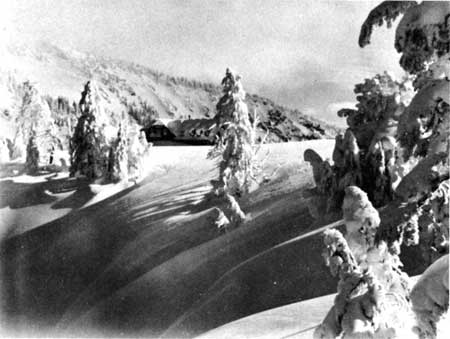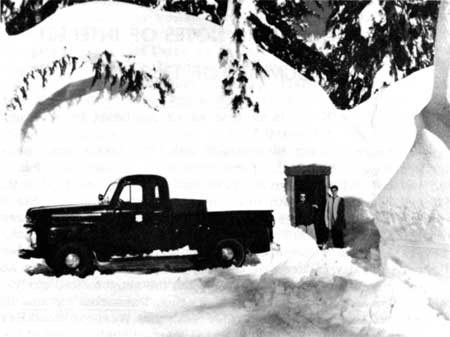|
Volume XVIII - 1952

The Big Snow of 1951-52
By Louis W. Hallock, Chief Ranger
The winter of 1951-52 at Crater Lake was preceded by a long dry
summer during which there was practically no precipitation after May 13
until the first general fall storms. Most of the residents of the park
were anticipating an "easy" winter but by April of 1952 all of us knew
we had been through a winter of record breaking snowfall and snow
depths.
Weather records have been kept in the park for about 26 years except
for the war years and these records show that the average snowfall for
Crater Lake is 622.0 inches. This average has been exceeded each year
since 1948 and for several winters previously. The record snowfall for
the park occurred during the winter of 1932-33 when 879.0 inches of
snowfall was recorded between October 1, 1932 and September 30, 1933,
which is the weather year for the park.
Snow depths on the ground are in direct proportion to the snowfall
so that recorded depths of between 100 inches and 200 inches of snow are
common. These greatest depths of snow usually occur during the months of
January, February, and March. For example, snow depths for March 1949,
1950, and 1951 were recorded at the Park Headquarters weather station as
171, 180, and 197 inches respectively.
The past winter, however, while not breaking any records for
snowfall did result in the greatest recorded depths of snow on the
ground since park records have been kept. On March 1, 1952 there was 177
inches of snow on the ground which was only 31 inches from the record. A
storm which began on the 3rd and ended on the 8th resulted in 39 inches
of snowfall and increased the total depth to 200 inches. It was at this
point we realized that if the normal cycle of storms continued, we would
break a record. Thereafter, each storm, even though adding to our
inconvenience of living and working in heavy snow, was watched with
interest and anticipation. Another storm moved in from the southwest on
the 9th and continued through the 15th and gave us another 38 inches of
snowfall. The depth as recorded reached 201 inches, only 7 inches shy of
the record we still hoped would be broken. There still remained 15 days
of the month of heaviest snowfall - we should see the record broken.
March 16 was clear and comparatively warm, maximum temperature 37
degrees. Still another storm crossed the Cascades on the 17th and
continued through the 20th. This storm carried enough moisture to
satisfy our anticipation. In four days 42 inches of snow fell. At the
beginning of this four day period the measured depth on the ground was
198 inches. On the second day a total depth of 207 inches was recorded -
only one inch shy of the record. Then on the 18th 6 inches of snow fell
followed by 10 inches more on the 19th. This was it! At 4:00 P.M. on the
19th the measuring stake recorded 216 inches. The record had been
smashed but it continued snowing, and we speculated on how much greater
the depth would be. On the morning of March 20, 1952 the measurement
reached 224 inches of snow on the ground. During the day, however, the
storm moved on and the new snow gradually settled to 218 inches, still a
record.
By the end of March there had been measured 798 inches of snowfall,
and we now set our sights on the breaking of the record for total
snowfall, but this was not to be. The last snowfall on June 14, brought
the total to 835 inches, some 44 inches short of a record.
The snowpack for the winter, which is measured periodically to
determine water content, was found to be more compact and with more
water than for many years previously. Water users in the entire state of
Oregon were assured an ample supply for the coming season.


The big snow of 1951-52 as shown by Chief Ranger
Hallock's photographs.
| 
